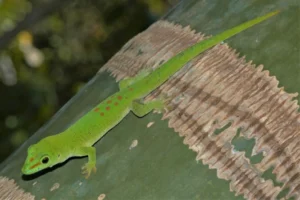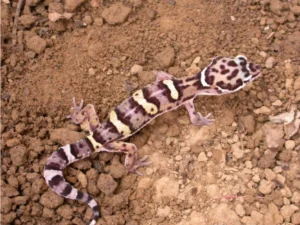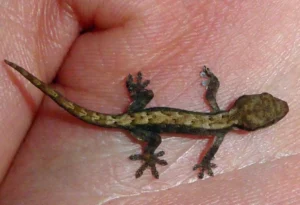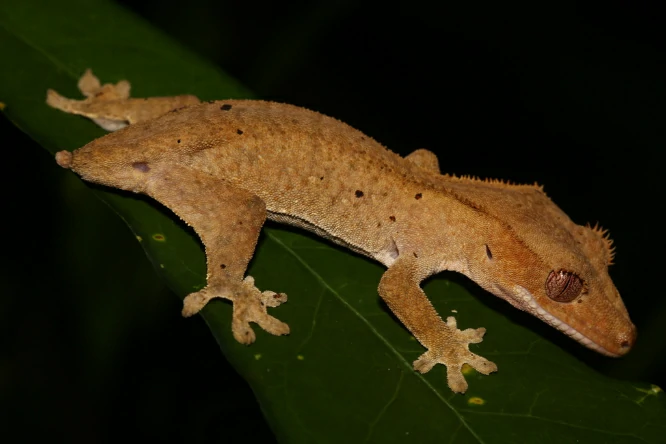You look into your gecko’s tank and freeze. The little creature that was bright and alert yesterday is now completely still, and its skin looks darker than ever. Almost black. Your first thought is panic. Do geckos really turn black when they die?
Yes, some geckos can look dark or even black when they die. The color change happens because blood stops moving, pigment cells stop working, and the body temperature drops. It’s a normal part of what happens after death, not always a sign of disease or suffering.
Still, not every gecko turns black. Sometimes they fade to white, other times they darken before lightening again.
It depends on the species, the lighting, and what’s happening inside the body.
Why a Gecko’s Skin Can Turn Dark After Death
When a gecko is alive, tiny pigment cells under its skin, called chromatophores, are always adjusting color.
They expand or shrink depending on light, mood, and temperature.

When the gecko dies, those cells stop working. Blood stops flowing, oxygen stops reaching tissues, and the body starts cooling.
These changes make the skin look darker at first.
Think of it like a screen that’s been turned off: all the bright, living movement inside disappears, leaving a dull, shadowed surface behind.
The Role of Temperature: Why Cold Geckos Look Darker
Geckos rely on outside heat to keep their body temperature stable. When they get cold, their skin darkens to soak up more warmth, like wearing a black sweater in winter.
If a gecko dies while it’s still cool, the pigment cells can stay expanded. That makes it look darker, sometimes almost black.
Many keepers notice their gecko looks darkest right after death, before slowly fading as the skin dries.
The darkness isn’t decay, it’s just the frozen state of the color cells at the moment life stopped.
What Happens Right After Death?
As soon as the heart stops, circulation ends. Without circulation, oxygen no longer reaches the pigment cells, and blood settles in the lower parts of the body.

This can make the underside darker while the top dries faster. That uneven dark and light pattern sometimes makes it look like the whole gecko turned black.
In reality, it’s just gravity and natural chemistry doing their quiet work.
Do All Gecko Species Turn Black When They Die?
No, the color change depends on the gecko’s natural pigments.
-
Leopard geckos often fade to gray or dull yellow, not black.
-
Crested geckos and tokay geckos might darken, especially if their base color is brown or red.
-
House geckos sometimes turn almost charcoal-gray before drying out.
Species with darker base colors show the change more clearly. Lighter species may just look faded instead of blackened.
So while “turns black when it dies” isn’t true for every gecko, it is for many, especially those with darker or heat-sensitive skin.
How Moisture and Humidity Affect the Color
Humidity can make a dead gecko look even darker. After death, the skin starts losing moisture. But if the tank is still humid, the outer layers stay slightly damp.

Damp skin reflects light differently. It can look shiny, deeper in color, sometimes almost oily black.
That effect usually fades as the body dries. Within a few hours or a day, most geckos start to lighten again, moving toward gray or off-white as dehydration sets in.
Basically, if the body stays warm and damp, it’ll look darker longer. If it’s dry and cool, it’ll pale faster.
Is Turning Black a Sign of Sickness or Poor Care?
Not necessarily.
Color alone doesn’t tell you how or why a gecko died. A gecko can darken after death even if it was completely healthy.
The color change is just a side effect of the body shutting down, not a symptom of disease.
That said, if your gecko looked dark before death, it might point to stress, cold, or illness. Geckos under stress often darken to conserve heat or show discomfort.
If you noticed dark skin along with sluggish behavior or poor appetite before death, it might help to check temperature or humidity in the enclosure.
But if the color only changed after death, it’s just the normal process.
Why Some Geckos Turn Black Before Dying
Sometimes, geckos start darkening a few hours before death. This can happen if their organs are failing, or if they’re extremely cold or dehydrated.
The skin reacts automatically, expanding pigment cells; a final response to low oxygen or body failure.
This pre-death darkening can look like bruising or deep shadows under the skin. The gecko doesn’t feel this; it’s purely biological.
Once circulation stops completely, the color stays frozen in that dark state until it slowly fades.
Comparing White vs. Black After Death: What’s the Difference?
It’s easy to get confused because some geckos turn white, others black, and some do both in stages.
Here’s what usually happens:
-
Immediately after death: The body cools, and the skin darkens slightly.
-
A few hours later: Blood settles and tissues start drying.
-
After a day or two: Pigments fade, and the body often looks paler or white.
So a gecko that looks black at first might later appear light gray or white. You’re seeing different parts of the same natural process, not separate events.

In short, turning black can just be an early stage of turning pale.
The Role of Lighting and Tank Setup
Light can play tricks on your eyes too.
Under bright LED or UV lights, dry skin looks lighter. Under dim, warm light (like evening tank light or natural shadows) the same body might look dark or black.
That’s why one keeper might call a dead gecko black, while another says gray or pale. Lighting makes a big difference.
If you’ve ever looked at your gecko’s shed skin under different lights, you’ve seen how much brightness changes what color looks like.
How to Tell if a Dark Gecko Is Dead or Sleeping
If your gecko looks darker than usual and is still, it might not be dead, especially during the day. Some geckos darken slightly when sleeping or cooling off.
To check safely:
-
Look closely at the chest or sides for slow breathing.
-
Gently tap the tank, never poke or shake the gecko.
-
See if the eyes respond to light.
If there’s no movement, no breathing, and the eyes look dull or sunken, it’s probably dead. But take a few minutes to be sure before assuming the worst.
What You Should Do When It Happens
If your gecko has died and darkened, handle the body carefully. Use gloves or a tissue to move it, and place it in a small box or container for burial.
Clean the tank thoroughly before reusing it. Wash all surfaces with reptile-safe disinfectant and rinse well. If you have other reptiles, keep their enclosures separate until cleaning is done.
If you suspect illness, you can keep the body in the fridge (not freezer) and contact a reptile vet for a necropsy. This can help rule out contagious causes.
How Color After Death Differs From Decay
A gecko turning black isn’t the same as decomposing.
The initial darkening happens because of pigment cells and blood settling, not rot. True decay takes longer and usually comes with odor, texture changes, and bacterial growth.
So if your gecko’s color changed but there’s no smell or visible breakdown, it’s just the natural post-mortem color change, not decomposition.
Conclusion
So, do geckos turn black when they die?
Yes, they can, and quite often do. It’s not always immediate, and it doesn’t mean they suffered.
The black comes from pigment cells freezing in place, blood settling, and the body cooling down.
Some geckos darken first and then fade to white as they dry. Others stay deep brown or gray.
Each follows its own small path through the same quiet process.
Hi, my name is Ezra Mushala, i have been interested animals all my life. I am the main author and editor here at snakeinformer.com.

